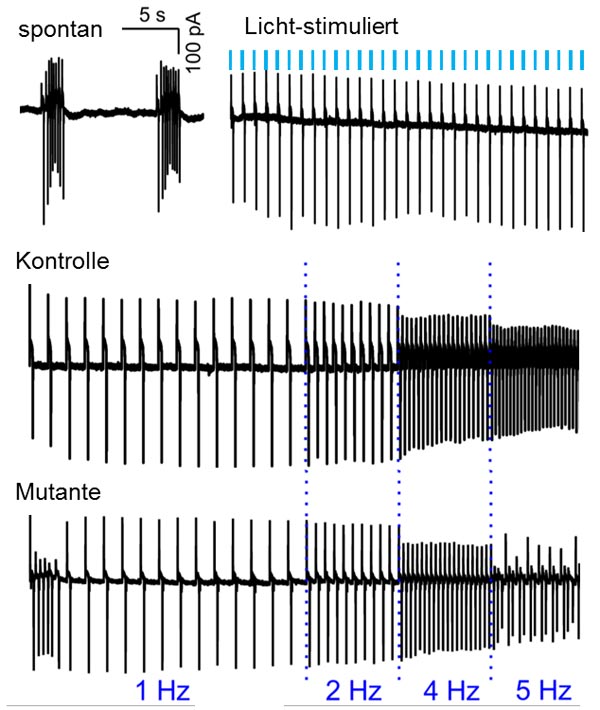Studying cardiac arrhythmias in nematodes

Researchers at the Goethe University have developed a simple model using the nematode Caenorhabditis elegans that can be used to test substances for treating genetically-mediated cardiac arrhythmias. They used the nematode feeding apparatus for this purpose, a rhythmically active muscle pump that resembles the muscle cells in the mammalian heart. This could be an important step on the road to personalised treatment.
Cardiac arrhythmias often have genetic causes. The same mutation is often detected in patients with the same type of arrhythmia. However, it is not clear from the outset whether other mutations in the same gene have the same effects. The effects of the arrhythmia could also differ depending on the type of mutation.
This knowledge could definitely be significant for treatment. This is because a type of medication that works particularly well for a specific mutation could be less beneficial for other mutations. Researchers have long been searching for a simple model that can be used to create certain genetic defects and in which the efficacy of substances can be tested.
The research group, led by Alexander Gottschalk at the Institute of Biochemistry and the Buchmann Institute at the Goethe University, used the nematode Caenorhabditis elegans because it is easy to modify it genetically. The nematode feeding apparatus uses ion channels similar to those in muscle cells of the mammalian heart. Ion channels play an important role in regulating cardiac muscle excitation, and mutations in their genes often lead to arrhythmias.
The researchers used optogenetic techniques, since the feeding apparatus, i.e. the pharynx, does not naturally pump as regularly as required in order to recognise arrhythmias. They introduced photo-activated ion channels into the muscle cells using a genetic approach. In this way, the apparatus can be transformed into a light-activated muscle pump with highly regular action. They then introduced various ion channel mutations, which are responsible for the so-called Timothy syndrome (LQT8) in humans. In practice, the mutated pharynx then demonstrated aberrant pump behaviour.
“We were able to improve or reverse these arrythmic effects using a substance that is already known to be pharmacologically active, and which is administered to patients with Timothy syndrome in a modified form”, explains Prof Alexander Gottschalk. The goal is to use the worm to search for new active substances for other types of arrhythmia.
These could even potentially be patient-specific if the exact mutation is transferred to the worm. The ease of genetic mutability of the nematode is highly advantageous in this regard when compared to a mouse model, which would be very difficult to generate. In order to facilitate the search for new medications, the researchers also developed a new optical method with which several animals can be analysed in parallel.
Publication: C. Schüler, E. Fischer, L. Shaltiel, W. Steuer Costa, A. Gottschalk. (2015) Arrhythmogenic effects of mutated L-type Ca2+-channels on an optogenetically paced muscular pump in Caenorhabditis elegans. Scientific Reports 5: 14427.
DOI: 10.1038/srep14427
Informationen: Prof. Alexander Gottschalk, Institut für Biochemie, Campus Riedberg, Tel.: (069) 798-42518, a.gottschalk@em.uni-frankfurt.de.
An image is available for download at: www.uni-frankfurt.de/58253225
Image text: The feeding apparatus (pharynx) of an optogentically modified nematode can reliably follow various “commando” frequencies (blue text). The control shows the reaction in a healthy worm. Below, a “sick” worm with a defective calcium channel that pumps irregularly at high frequencies.
Goethe University is a research-oriented university in the European financial centre Frankfurt founded in 1914 with purely private funds by liberally-oriented Frankfurt citizens. It is dedicated to research and education under the motto “Science for Society” and to this day continues to function as a “citizens’ university”. Many of the early benefactors were Jewish. Over the past 100 years, Goethe University has done pioneering work in the social and sociological sciences, chemistry, quantum physics, brain research and labour law. It gained a unique level of autonomy on 1 January 2008 by returning to its historic roots as a privately funded university. Today, it is among the top ten in external funding and among the top three largest universities in Germany, with three clusters of excellence in medicine, life sciences and the humanities.
Media Contact
More Information:
http://www.uni-frankfurt.deAll latest news from the category: Life Sciences and Chemistry
Articles and reports from the Life Sciences and chemistry area deal with applied and basic research into modern biology, chemistry and human medicine.
Valuable information can be found on a range of life sciences fields including bacteriology, biochemistry, bionics, bioinformatics, biophysics, biotechnology, genetics, geobotany, human biology, marine biology, microbiology, molecular biology, cellular biology, zoology, bioinorganic chemistry, microchemistry and environmental chemistry.
Newest articles

Properties of new materials for microchips
… can now be measured well. Reseachers of Delft University of Technology demonstrated measuring performance properties of ultrathin silicon membranes. Making ever smaller and more powerful chips requires new ultrathin…

Floating solar’s potential
… to support sustainable development by addressing climate, water, and energy goals holistically. A new study published this week in Nature Energy raises the potential for floating solar photovoltaics (FPV)…

Skyrmions move at record speeds
… a step towards the computing of the future. An international research team led by scientists from the CNRS1 has discovered that the magnetic nanobubbles2 known as skyrmions can be…





















